
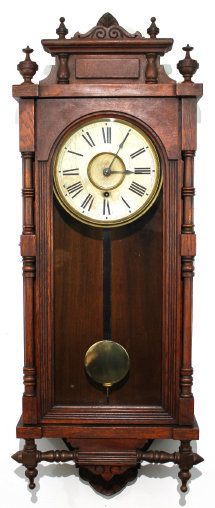
427. $295
Ansonia “Queen Elizabeth”, 1901. This is the later version of this clock, with the 1880 version
having a different crest and base. It is a 37-inch oak case with a dark finish in need of renewal. The glass is old as
is the signed paper dial, which also could stand to be renewed; we can do that for you for $25. The hands are new, the pendulum
bob old and with a spot of oxidation near the pendulum stick. It holds an 8-day time-only signed movement that is running and
keeping time. Nice label on the back. A number of recent sales on eBay, averaging $330 over the last several years.

429. $1800
Southern Calendar Clock Co. “Fashion No. 5”, 1875-1889. The No. 5 has the long-drop pendulum
and recessed seconds bit dial. The case is walnut, nicely refinished, and the dials have been repainted and calendar rollers
repapered. The finials are replacements. The glass is new and the Fashion lettering are decals. The hands are correct
as is the signed Seth Thomas movement, the calendar movement, and the cathedral gong. The pendulum bob is normally nickel with
a damascened pattern but this one is brass. Not sure that matters, as it is not visible. The clock is running and the
calendar is advancing. Fashion No. 5’s are pretty uncommon; Schmitt’s sold one in 2014 for $1600 and Harris sold one in the
same year for $2500. We sold this clock in 2015 for $2075.
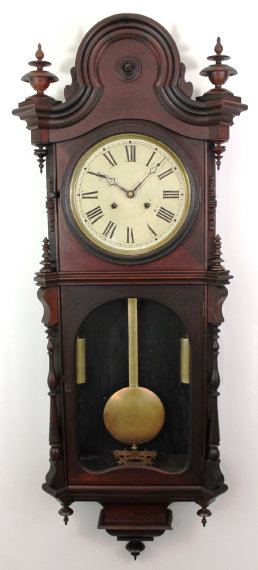
430. $2350
Welch, Spring & Co. “Regulator No. 5”, ca. 1874. Welch, Spring & Co. made several
models in this same style, differing in size and movement (spring or weight-driven). This model is the second largest, behind
the 68-inch No. 1 Regulator. It is 51 inches in length, top to tip of bottom finial, and driven by two brass weights. It is time only, running fifteen days. The case is walnut with a dark finish, possibly original, with some crustiness in places. The diagonal variation in color of the two halves around the dial is due to a change in grain direction and the bright lighting for
photography, and is unnoticeable in normal light. There is a chip to a trim piece on the right side of the base that is not
noticeable, and one top finial has a large chip that can be faced to the back, making it unnoticeable. All the finials look
original. The glass in the door is wavy and probably original, the dial glass has been replaced. One lower side
glass has been replaced, possibly both as the putty holding them in is new. There is a key and working lock on the door. The painted dial has some chips, especially around the winding ports. The hands are original. The pendulum bob and stick
look original, as do the weights and beat scale. The bob and stick show some wear and one weight shell has a small gash that
can be faced to the back. The clock is running and keeping time, although it is sensitive to position. Although some examples
of this model have a seconds bit, the catalog photos show this clock without. The most recent sale in the Antique Clocks Price
Guide was for $2700 at Schmitt’s in 2011, and it lacked the bottom finials. Includes a Welch winding key. $2400-$2800.
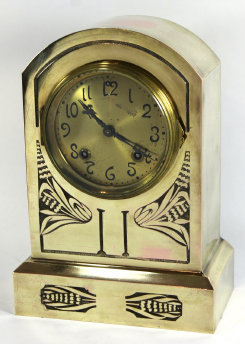
428. $210
Ansonia “Surrey”, ca. 1910. Ansonia put out a number of metal case clocks in the early 1900’s
with a “Colonial Brass Finish” and all of them have suffered the same fate over the years, with the brass finish being worn off by
excessive polishing. This one is in better shape than most, but still has its issues. You can see that it has been buffed
to a bright shine and can also see spots where the copper undercoating is showing through. There is some fine pitting on the
sides, and some spots where there is still tarnish. Shiny clocks are next to impossible to photograph and all the imperfections
seem to be magnified, so please consider that this clock looks great from a more reasonable distance. There are some scrapes
and wear to the dial, and some of the numbers have been touched up. It has an 8-day half-hour strike movement that is running
and keeping time. Sale prices for these brass clocks vary with the quality of the finish, ranging from $100 to $250.
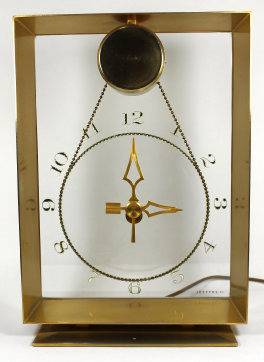
431. $225
Jefferson Electric Co. “Suspense”, ca. 1958. The Suspense is the largest of the mystery
clocks produced by Jefferson Electric Company. It is just over 13 inches tall, finished in 24K gold over a zinc alloy. This finish here is pretty good, but overzealous cleaning has removed some of the gold finish on the sides and base. The lettering
on the glass shows no losses; the dial is plexiglass, suspended by a beaded chain. As with the Golden Hour clock, the dial turns
and the hands are attached to the dial, with the hour hand swinging freely and geared down from the minute hand and dial. The
motor at the top turns the chain. The motor is a bit noisy but is running and keeping time. The cord and plug are original. We sold one in our last auction for $240. $225-$300.

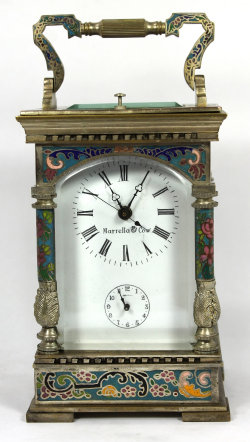
432. $750
French champlevé repeater carriage clock, ca. 1900. This multicolored enamel champlevé
carriage is 8 inches tall with the handle up. The case is silver- or nickel-plated and most of the plating is still present,
although it shows areas of tarnish that would no doubt clean up with Nevr Dull wadding polish or Simichrome. It has a white
enamel dial signed “Marrella & Co.” with trefoil hands, a seconds hand, and an alarm dial. There are four beveled, arched
glasses and a beveled glass on top over the silver platform lever escapement with jeweled pallets. The clock is running, fast,
but the strike is out of sequence and I don’t know how to adjust that. There are way too many armatures and gears in the back
to sort out. I assume it is an eight-day movement. The handle is also lost from the back door and so it’s best not to
close tightly. It’s not signed anywhere, and the country of origin is not indicated. It’s really quite nice and only needs
a bit of polish to really make it sparkle. Two keys are included. A similar clock in gold can be seen on page 180 of Derek
Roberts’ book “Carriage and other traveling clocks”. Champlevé clocks sell from $500 to $1500 and up.